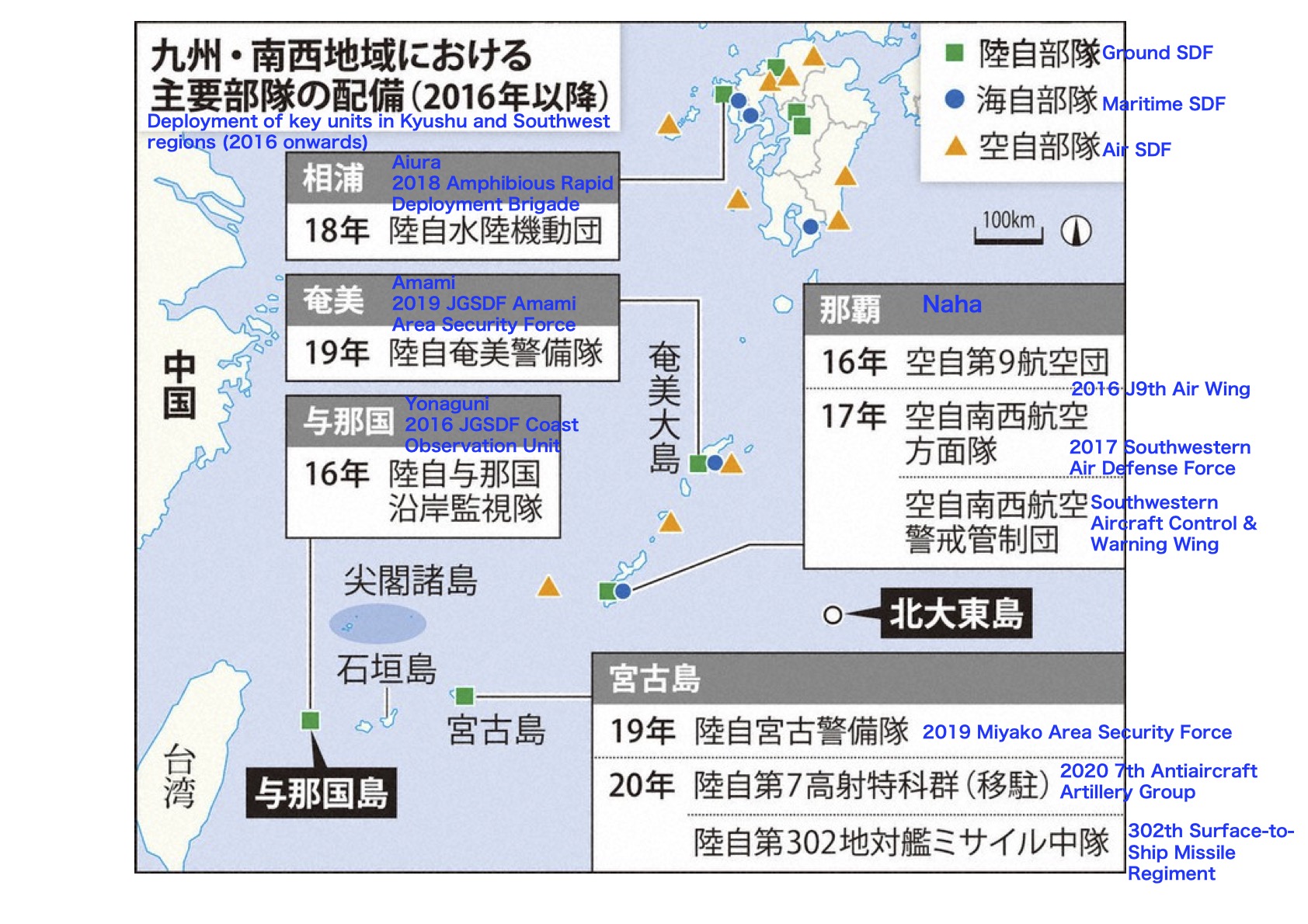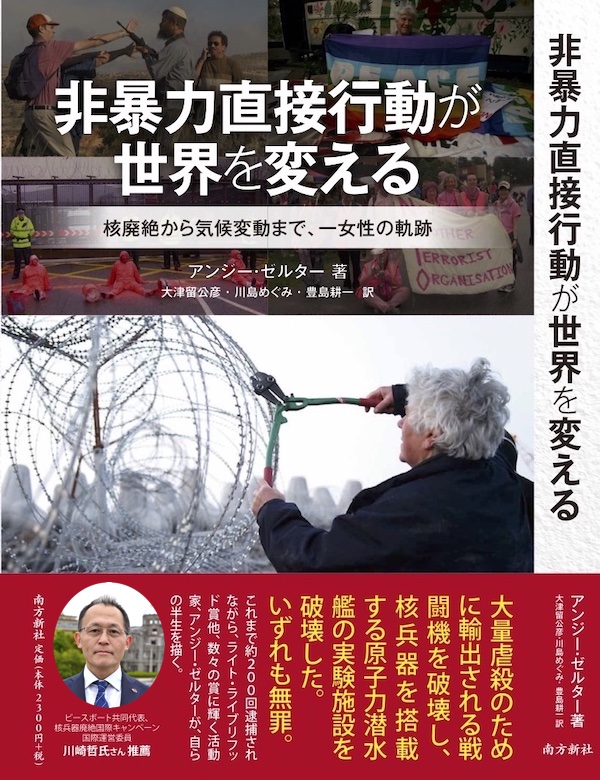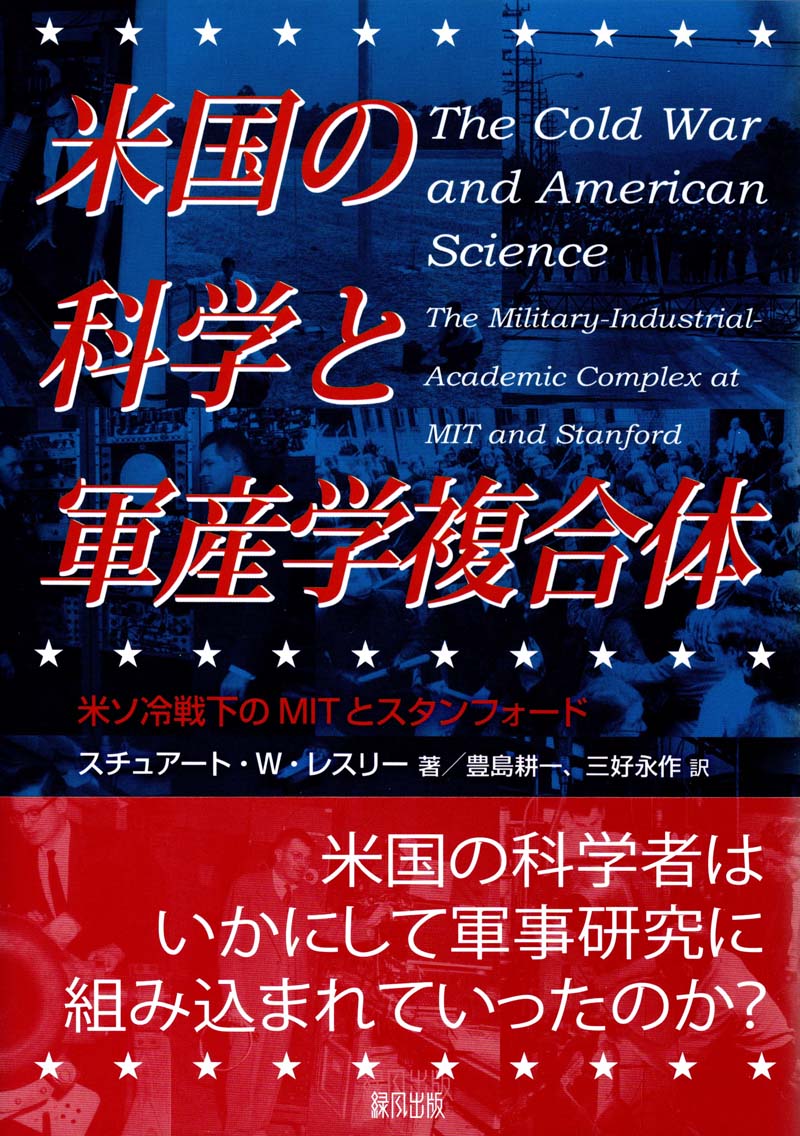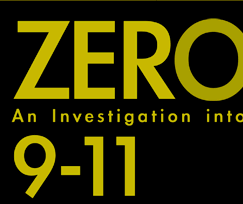How to 'cancel' the "New Prewar Period" [反核・平和]
This is the English version of the text posted on April 12, an article that appeared in the latest issue of "Fukuoka Prefecture University and Researcher Supporters' Association News" (the supporters' association of the Communist Party), which is an update of the article "The 'Military Fortification' of the Nansei Islands and the Constitutional Movement" that appeared in the same paper three years ago.
-------
How to 'cancel' the "New Prewar Period"
-- Self-Defense Forces' Military Expansion to Nansei Islands
Koichi Toyoshima
 (The word "New Prewar Period" became popular since famous TV star Tamori used this in the popular TV show "Tetsuko no Heya". see photo.)
(The word "New Prewar Period" became popular since famous TV star Tamori used this in the popular TV show "Tetsuko no Heya". see photo.)
Although I am not particularly knowledgeable about military issues in general, not only the issue of the military fortification of the Nansei(south-western) Islands, I was asked to write a manuscript for this bulletin four years ago in connection with my articles published in issues 90 and 91. I would like to summarize my findings by searching related websites and news reports as much as possible, and also to express some opinions.
In my previous article, I pointed out that although this is clearly the latest and most serious movement to prepare for war, there is hardly any peace movement to oppose it, especially on the mainland, and the amount of coverage in the general newspapers as well as in "Aka-hata"(JCP’s newspaper) is too small. Unfortunately, the opposition movement did not grow significantly, and on March 16, the GSDF was allowed to expand into Ishigaki Island, the only island in the Nansei Islands that did not have a base.
However, since last year, the so-called "Taiwan contingency" has been widely publicized in the media, and with last year's "Three Security Documents" authorizing military expansion and hostile land attacks, and the doubled budget for military spending, it has become clear to many that Japan is now pushing toward war, and that the expansion of the Self Defense Forces in the Nansei Islands is the very fuse for such a war. The Center for Strategic and International Studies (CSIS) of the U.S. released a report on the desk exercises, and the scale of the enormous losses incurred by Japan, the U.S., and China in many "scenarios" was reported1. (The "losses" do not include the human and material losses to the local residents.)
First, let us take a brief look at the history of the deployment of the Self-Defense Forces to the Nansei Islands(see figure at the end). The first Self-Defense Force base was established in 1971 when Okinawa returned to mainland Japan, taking over the U.S. military radar unit on Miyakojima2. In 2009, a radio interception unit was established here for the purpose of countering China3. In March 2016, a GSDF garrison and coastal surveillance unit were established on Yonaguni Island, and in 2019, GSDF garrisons were established on Amami Oshima Island and Miyakojima, with a missile unit subsequently deployed to Miyakojima Island. And in March 2023, a GSDF base will be established on Ishigaki Island, the only island in the Nansei Islands that has not had a base.
It is not just far away from where we live. A situation closely related to the "southwest shift" and the "Taiwan contingency" is rapidly developing right under our noses as well. This is the case with the deployment of the Osprey at Saga Airport (i.e., the establishment of a new Self-Defense Forces base in Saga City). The Ministry of Defense itself has clearly indicated in its briefing materials for local residents that this plan is integral to the military expansion of the Self-Defense Forces in the Nansei Islands, and I myself have emphasized this in my blog and other publications. Local opposition has naturally focused on the environmental destruction caused by the base, including noise, crash hazards, and pollution of the Ariake Sea, but recently there has been a growing awareness that this is a problem directly related to war and peace. For example, on March 24, NHK Saga news reported that local community presidents had expressed their approval of the planned deployment of the Osprey at Saga Airport, subject to conditions, and even mentioned the construction of underground shelters in case of missile attacks. These community leaders admitted that the deployment of the Osprey is a plan for war.
The staple of discourse to lead the public to war is always the "threat" of another country, and the reality of Russia's invasion of Ukraine gives this some persuasive force. In fact, the Mainichi article reporting the U.S. Center for Strategic and International Studies report above also states that while it would be preferable if war did not break out, "Russia's invasion of Ukraine, however, has shown the reality that war can break out due to the 'malice' of other nations," and that if the situation is recognized as an existential crisis, the Self Defense Force could use military force. The question, therefore, is how to convincingly refute this.
The "Taiwan contingency," if we assume the 1972 Japan-China Joint Statement, is a civil war in China, and there is no way that Japan would intervene in such a war. However, there is not enough space to discuss it in detail (as I have done repeatedly in my blog). I would like to seek a hint from a newspaper interview4 with Kurume-born author Aki Misaki when his novel "Tonarimachi Senso"(War with the Neighboring Town) was published.
He wrote, "If we can oppose stereotypical5 wars, but say 'it can't be helped' for wars that are a little more epigone, I think we will never be able to stop the trend toward approving wars. "
At the time of the Gulf War, it was "to overthrow a dictator, this time it can't be helped", but this time the language used to tacitly approve or justify the "Taiwan contingency," or preparations for war, is "to protect Taiwan from a dictatorial regime, it can't be helped". The key will be to defeat this discourse.
----------------
Notes
(1) Mainichi Shimbun, 28 February 2023. https://mainichi.jp/articles/20230227/k00/00m/030/145000c
Original paper: https://csis-website-prod.s3.amazonaws.com/s3fs-public/publication/230109_Cancian_FirstBattle_NextWar.pdf
(2) Japan Air Self-Defense Force website, "History of Miyakojima Sub-Base," https://www.mod.go.jp/asdf/miyako/rekishi/index.html
(3) Makoto Konishi, "The Self-Defense Forces' Southwest Shift," Shakai Hihyosha, 2018, p. 42.
(4) The image of the said article is placed in the author's blog post, "'Tonarimachi Senso' to Tonarikuni Senso". https://pegasus1.blog.ss-blog.jp/2023-03-24
(5) I assume he means "in general terms".

(from Mainichi-shinbun, May 2, 2022.)
-------
How to 'cancel' the "New Prewar Period"
-- Self-Defense Forces' Military Expansion to Nansei Islands
Koichi Toyoshima
 (The word "New Prewar Period" became popular since famous TV star Tamori used this in the popular TV show "Tetsuko no Heya". see photo.)
(The word "New Prewar Period" became popular since famous TV star Tamori used this in the popular TV show "Tetsuko no Heya". see photo.)Although I am not particularly knowledgeable about military issues in general, not only the issue of the military fortification of the Nansei(south-western) Islands, I was asked to write a manuscript for this bulletin four years ago in connection with my articles published in issues 90 and 91. I would like to summarize my findings by searching related websites and news reports as much as possible, and also to express some opinions.
In my previous article, I pointed out that although this is clearly the latest and most serious movement to prepare for war, there is hardly any peace movement to oppose it, especially on the mainland, and the amount of coverage in the general newspapers as well as in "Aka-hata"(JCP’s newspaper) is too small. Unfortunately, the opposition movement did not grow significantly, and on March 16, the GSDF was allowed to expand into Ishigaki Island, the only island in the Nansei Islands that did not have a base.
However, since last year, the so-called "Taiwan contingency" has been widely publicized in the media, and with last year's "Three Security Documents" authorizing military expansion and hostile land attacks, and the doubled budget for military spending, it has become clear to many that Japan is now pushing toward war, and that the expansion of the Self Defense Forces in the Nansei Islands is the very fuse for such a war. The Center for Strategic and International Studies (CSIS) of the U.S. released a report on the desk exercises, and the scale of the enormous losses incurred by Japan, the U.S., and China in many "scenarios" was reported1. (The "losses" do not include the human and material losses to the local residents.)
First, let us take a brief look at the history of the deployment of the Self-Defense Forces to the Nansei Islands(see figure at the end). The first Self-Defense Force base was established in 1971 when Okinawa returned to mainland Japan, taking over the U.S. military radar unit on Miyakojima2. In 2009, a radio interception unit was established here for the purpose of countering China3. In March 2016, a GSDF garrison and coastal surveillance unit were established on Yonaguni Island, and in 2019, GSDF garrisons were established on Amami Oshima Island and Miyakojima, with a missile unit subsequently deployed to Miyakojima Island. And in March 2023, a GSDF base will be established on Ishigaki Island, the only island in the Nansei Islands that has not had a base.
It is not just far away from where we live. A situation closely related to the "southwest shift" and the "Taiwan contingency" is rapidly developing right under our noses as well. This is the case with the deployment of the Osprey at Saga Airport (i.e., the establishment of a new Self-Defense Forces base in Saga City). The Ministry of Defense itself has clearly indicated in its briefing materials for local residents that this plan is integral to the military expansion of the Self-Defense Forces in the Nansei Islands, and I myself have emphasized this in my blog and other publications. Local opposition has naturally focused on the environmental destruction caused by the base, including noise, crash hazards, and pollution of the Ariake Sea, but recently there has been a growing awareness that this is a problem directly related to war and peace. For example, on March 24, NHK Saga news reported that local community presidents had expressed their approval of the planned deployment of the Osprey at Saga Airport, subject to conditions, and even mentioned the construction of underground shelters in case of missile attacks. These community leaders admitted that the deployment of the Osprey is a plan for war.
The staple of discourse to lead the public to war is always the "threat" of another country, and the reality of Russia's invasion of Ukraine gives this some persuasive force. In fact, the Mainichi article reporting the U.S. Center for Strategic and International Studies report above also states that while it would be preferable if war did not break out, "Russia's invasion of Ukraine, however, has shown the reality that war can break out due to the 'malice' of other nations," and that if the situation is recognized as an existential crisis, the Self Defense Force could use military force. The question, therefore, is how to convincingly refute this.
The "Taiwan contingency," if we assume the 1972 Japan-China Joint Statement, is a civil war in China, and there is no way that Japan would intervene in such a war. However, there is not enough space to discuss it in detail (as I have done repeatedly in my blog). I would like to seek a hint from a newspaper interview4 with Kurume-born author Aki Misaki when his novel "Tonarimachi Senso"(War with the Neighboring Town) was published.
He wrote, "If we can oppose stereotypical5 wars, but say 'it can't be helped' for wars that are a little more epigone, I think we will never be able to stop the trend toward approving wars. "
At the time of the Gulf War, it was "to overthrow a dictator, this time it can't be helped", but this time the language used to tacitly approve or justify the "Taiwan contingency," or preparations for war, is "to protect Taiwan from a dictatorial regime, it can't be helped". The key will be to defeat this discourse.
----------------
Notes
(1) Mainichi Shimbun, 28 February 2023. https://mainichi.jp/articles/20230227/k00/00m/030/145000c
Original paper: https://csis-website-prod.s3.amazonaws.com/s3fs-public/publication/230109_Cancian_FirstBattle_NextWar.pdf
(2) Japan Air Self-Defense Force website, "History of Miyakojima Sub-Base," https://www.mod.go.jp/asdf/miyako/rekishi/index.html
(3) Makoto Konishi, "The Self-Defense Forces' Southwest Shift," Shakai Hihyosha, 2018, p. 42.
(4) The image of the said article is placed in the author's blog post, "'Tonarimachi Senso' to Tonarikuni Senso". https://pegasus1.blog.ss-blog.jp/2023-03-24
(5) I assume he means "in general terms".

(from Mainichi-shinbun, May 2, 2022.)
2023-04-29 17:27
nice!(0)
コメント(0)






 9条守ろう! ブロガーズ・リンク
9条守ろう! ブロガーズ・リンク



コメント 0